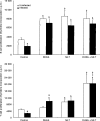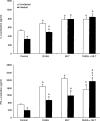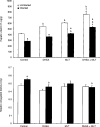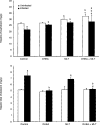Prevention of immune dysfunction and vitamin E loss by dehydroepiandrosterone and melatonin supplementation during murine retrovirus infection
- PMID: 10233708
- PMCID: PMC2326749
- DOI: 10.1046/j.1365-2567.1999.00628.x
Prevention of immune dysfunction and vitamin E loss by dehydroepiandrosterone and melatonin supplementation during murine retrovirus infection
Abstract
Female C57BL/6 mice infected with the LP-BM5 leukaemia retrovirus developed murine acquired immune-deficiency syndrome (AIDS). Dehydroepiandrosterone (DHEA) and melatonin (MLT) modify immune dysfunction and prevent lipid peroxidation. We investigated whether DHEA and MLT could prevent immune dysfunction, excessive lipid peroxidation, and tissue vitamin E loss induced by retrovirus infection. Retrovirus infection inhibited the release of T helper 1 (Th1) cytokines, stimulated secretion of Th2 cytokines, increased hepatic lipid peroxidation, and induced vitamin E deficiency. Treatment with DHEA or MLT alone, as well as together, largely prevented the reduction of B- and T-cell proliferation as well as of Th1 cytokine secretion caused by retrovirus infection. Supplementation also suppressed the elevated production of Th2 cytokines stimulated by retrovirus infection. DHEA and MLT simultaneously reduced hepatic lipid peroxidation and prevented vitamin E loss. The use of DHEA plus MLT was more effective in preventing retrovirus-induced immune dysfunction than either DHEA or MLT alone. These results suggest that supplementation with DHEA and MLT may prevent cytokine dysregulation, lipid oxidation and tissue vitamin E loss induced by retrovirus infection. Similarly, hormone supplementation also modified immune function and increased tissue vitamin E levels in uninfected mice.
Figures





Similar articles
-
Cytokine dysregulation and increased oxidation is prevented by dehydroepiandrosterone in mice infected with murine leukemia retrovirus.Proc Soc Exp Biol Med. 1997 Dec;216(3):386-91. doi: 10.3181/00379727-216-44186. Proc Soc Exp Biol Med. 1997. PMID: 9402143
-
Prevention of retrovirus-induced aberrant cytokine secretion, excessive lipid peroxidation, and tissue vitamin E deficiency by T cell receptor peptide treatments in C57BL/6 mice.Proc Soc Exp Biol Med. 1997 Jan;214(1):87-94. doi: 10.3181/00379727-214-44074. Proc Soc Exp Biol Med. 1997. PMID: 9012366
-
Vitamin E deficiency and immune dysfunction in retrovirus-infected C57BL/6 mice are prevented by T-cell receptor peptide treatment.J Nutr. 1996 May;126(5):1389-97. doi: 10.1093/jn/126.5.1389. J Nutr. 1996. PMID: 8618135
-
Murine AIDS, a key to understanding retrovirus-induced immunodeficiency.Viral Immunol. 1996;9(4):225-39. doi: 10.1089/vim.1996.9.225. Viral Immunol. 1996. PMID: 8978019 Review.
-
Resistance to intestinal parasites during murine AIDS: role of alcohol and nutrition in immune dysfunction.Parasitology. 1993;107 Suppl:S69-74. doi: 10.1017/s003118200007551x. Parasitology. 1993. PMID: 8115187 Review.
Cited by
-
Dehydroepiandrosterone alters vitamin E status and prevents lipid peroxidation in vitamin E-deficient rats.J Clin Biochem Nutr. 2016 May;58(3):223-31. doi: 10.3164/jcbn.15-133. Epub 2016 Apr 13. J Clin Biochem Nutr. 2016. PMID: 27257348 Free PMC article.
-
Hyperandrogenism induces a proinflammatory TNFα response to glucose ingestion in a receptor-dependent fashion.J Clin Endocrinol Metab. 2014 May;99(5):E848-54. doi: 10.1210/jc.2013-4109. Epub 2014 Feb 10. J Clin Endocrinol Metab. 2014. PMID: 24512496 Free PMC article. Clinical Trial.
-
Melatonin: buffering the immune system.Int J Mol Sci. 2013 Apr 22;14(4):8638-83. doi: 10.3390/ijms14048638. Int J Mol Sci. 2013. PMID: 23609496 Free PMC article. Review.
-
Beneficial actions of melatonin in the management of viral infections: a new use for this "molecular handyman"?Rev Med Virol. 2012 Sep;22(5):323-38. doi: 10.1002/rmv.1714. Epub 2012 Apr 18. Rev Med Virol. 2012. PMID: 22511571 Free PMC article. Review.
-
Hyperandrogenism sensitizes mononuclear cells to promote glucose-induced inflammation in lean reproductive-age women.Am J Physiol Endocrinol Metab. 2012 Feb 1;302(3):E297-306. doi: 10.1152/ajpendo.00416.2011. Epub 2011 Nov 1. Am J Physiol Endocrinol Metab. 2012. PMID: 22045316 Free PMC article. Clinical Trial.
References
-
- Liang B, Wang JY, Watson RR. Murine AIDS, a key to understanding retrovirus-induced immunodeficiecy. Viral Immunol. 1996a;98:225. - PubMed
-
- Bradley WG, Ogata N, Good RA, Day NK. Alteration of in vivo cytokine gene expression in mice infected with a molecular clone the defective MAIDS virus. J AIDS. 1993;7:1. - PubMed
-
- Gazzinelli RT, Makino M, Chattopadhyay SK, et al. CD4+ subset regulation in viral infection. Preferential activation of Th2 cells during progression of retrovirus-induced immunodeficiency in mice. J Immunol. 1992;148:182. - PubMed
-
- Wang Y, Huang DS, Liang B, Watson RR. Nutritional status and immune response in mice with murine AIDS are normalized by vitamin E supplementation. J Nutr. 1994;124:2024. - PubMed
Publication types
MeSH terms
Substances
Grants and funding
LinkOut - more resources
Full Text Sources
Other Literature Sources
Medical

